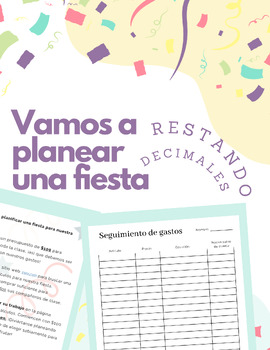Spanish Party Planning Budget Worksheet:Subtracting Decimals, Restando Decimales
- PDF
Description
Get ready for a fiesta with our 'Party Planning Budget Worksheet: Subtraction of Decimals' digital resource designed for teachers and students in Spanish! In this interactive activity, students will dive into the exciting world of party planning while mastering the essential skill of subtracting decimals. With a budget of $100, students will use Vons.com to select a variety of party items, carefully tracking their spending as they subtract the cost of each item from their total. This engaging worksheet provides students with a hands-on opportunity to practice subtraction of decimals in a real-world context, reinforcing their mathematical skills while planning the ultimate class celebration. Encourage your students to make thoughtful decisions and show their work as they subtract their way to party perfection!
¡Prepárense para una fiesta con nuestra hoja de trabajo digital 'Presupuesto para Planificar Fiestas: Resta Festiva' diseñada para profesores y estudiantes! En esta actividad interactiva, los estudiantes se sumergirán en el emocionante mundo de la planificación de fiestas mientras dominan la habilidad esencial de restar decimales. Con un presupuesto de $100, los estudiantes usarán Vons.com para seleccionar una variedad de artículos para la fiesta, mientras rastrean cuidadosamente sus gastos al restar el costo de cada artículo de su total. Esta hoja de trabajo envolvente brinda a los estudiantes una oportunidad práctica para practicar la resta de decimales en un contexto real, reforzando sus habilidades matemáticas mientras planifican la celebración de clase definitiva. ¡Anima a tus estudiantes a tomar decisiones reflexivas y a mostrar su trabajo mientras restan su camino hacia la perfección de la fiesta!


